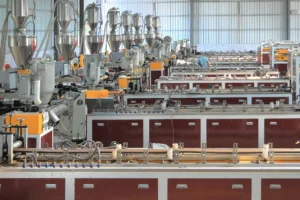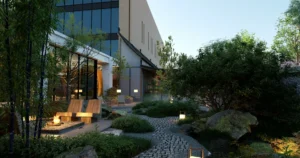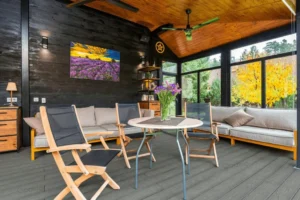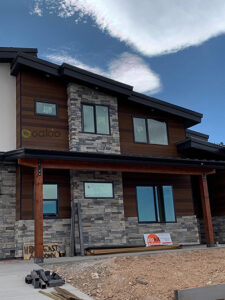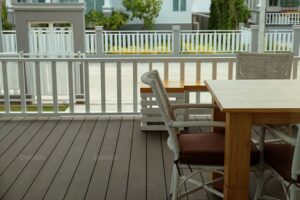Production Process of Bamboo Charcoal Fiber/Polyethylene Composite Flooring
Wood-plastic composites (WPC) have gained widespread adoption due to their cost-effectiveness, light weight, and high strength. For example, wood powder combined with polypropylene has been used in Ford’s interior lining, which facilitated the rapid utilization and development of WPC. Many researchers have explored the use of various plant fibers, such as bamboo, wheat straw, jute, and even coconut shells, combined with thermoplastic resins to improve the performance of composite materials.
However, significant challenges arise from the incompatibility between the hydrophobic nature of plastics and the hydrophilic nature of plant fibers. This incompatibility creates problems at the interface, severely affecting the uniform bonding of the raw materials and compromising the mechanical strength, durability, and other key properties of the final product. As a result, addressing the interface compatibility between plant fibers and plastics has become a core focus in the manufacturing of wood-plastic composites.

Biomass charcoal, a solid substance produced by the pyrolysis and carbonization of biomass materials in an oxygen-deprived environment, is highly aromatic and insoluble. In recent years, biomass charcoal has attracted attention for its excellent adsorption properties and has been used as a soil conditioner and controlled-release agent in agricultural applications. Biomass charcoal also exhibits excellent rigidity and surface activity, which indicates its potential for enhancing the preparation of composite materials. By using cost-effective biomass charcoal, new composite materials with unique performance properties can be developed, presenting promising opportunities for further application and providing new directions for biomass charcoal utilization.
Patent for Bamboo Charcoal Fiber-Polyethylene Composite Flooring Production Process
To address the above-mentioned issues, a patented method has been proposed for preparing bamboo charcoal fiber-polyethylene composite flooring. The invention utilizes a high-density polyethylene (HDPE) matrix in which ultra-fine bamboo charcoal ions are selectively distributed under an external magnetic field, forming a network structure of ultra-fine bamboo charcoal particles. This network structure enhances the material’s strength and modulus, and the particles can exhibit a synergistic reinforcing effect. This process significantly improves the mechanical properties and thermal characteristics of the composite material.
Technical Process:
The production process for bamboo charcoal fiber-polyethylene composite flooring includes the following steps:
Step 1: Mixing
- Ultra-fine bamboo charcoal, high-density polyethylene (HDPE), and a mixing aid are fed into a high-speed mixer to form a homogeneous mixture.
Step 2: Extrusion
- The mixture is then sent into a screw extruder. Under a constant external magnetic field, the mixture undergoes melt extrusion to produce the composite material.
Step 3: Injection Molding
- The composite material is injected into an injection molding machine, melted, and then cooled and shaped in a mold to form the final flooring product.
Mixing Aid:
- The mixing aid contains a coupling agent with magnetic-responsive metal ions.
To improve the interface compatibility between ultra-fine bamboo charcoal and HDPE, a coupling agent with magnetic responsiveness is used in combination with a constant magnetic field. The principle behind this technology involves the following processes:
- Alignment of Bamboo Charcoal: Under the influence of the magnetic field, the carbon atoms in the ultra-fine bamboo charcoal form ring structures. The magnetic field induces an induced magnetic moment, and this moment rotates under the influence of the magnetic field, causing the charcoal layers to align in a direction perpendicular to the field.
- Polyethylene Response: HDPE, a non-polar material, produces an induced dipole moment when in a molten state under the magnetic field. This alignment causes the spherulites to elongate in the direction of the magnetic field, leading to oriented crystallization. Under the external magnetic field, a “whisker-like” additional crystallization zone forms at the leading edge of the crystalline area, and the radial plate-like crystals grow in a straightened manner instead of a twisted one.
- Magnetic Coupling Agent: The metal ion coupling agent aligns along the crystal axis with the maximum magnetization under the magnetic field.
When the ultra-fine bamboo charcoal, metal ion coupling agent, and HDPE are mixed in the molten state, the oriented distribution of the ultra-fine bamboo charcoal particles facilitates their entry into the similarly oriented crystalline HDPE, reducing the gaps between them. The coupling agent enhances the interface bonding between HDPE and bamboo charcoal, “stitching” the crosslinked network. This results in a better encapsulation effect of HDPE around the bamboo charcoal and significantly enhances the mechanical properties of the composite material.
Conclusion
The proposed bamboo charcoal fiber-polyethylene composite flooring production process provides a cost-effective and efficient method for improving the performance of wood-plastic composites. By utilizing ultra-fine bamboo charcoal and magnetic-responsive coupling agents, this method not only addresses the interface compatibility issues but also enhances the overall mechanical and thermal properties of the composite material. This innovation has significant potential for broad application in the production of durable, high-performance composite flooring and other materials.
Trending Reading
What Are the Differences Between the WPC Board and PVC Board?
[2024 Update] How Long Does WPC Decking Last?
